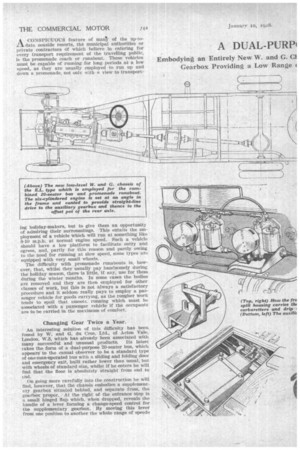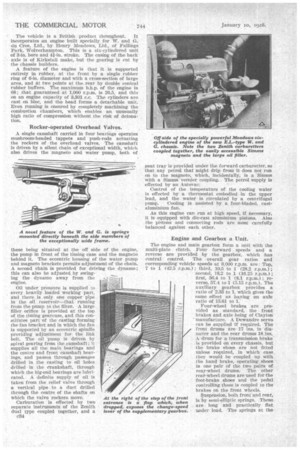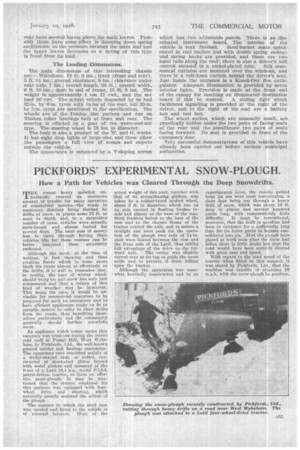A DUAL-PURP1 SEASIDE BUS.
Page 54

Page 55

Page 56

Page 57

If you've noticed an error in this article please click here to report it so we can fix it.
Embodying an Entirely New W. and G. Cl Gearbox Providing a Low Range ( , this E.L.-type Bus has a Special Auxiliary irs for Slow-speed Promenade Work.
ACONSPICUOUS feature of maulof the up-toate seaside resorts, the municipal authorities or private contractors of which believe in catering for every transport requirement of the travelling public, is the promenade coach or runabout.. These vehicles must be capable of running for long periods at a low speed, as they are usually employed to run up and down a promenade, not only with •a view to transport
hag holiday-makers, hut to give them an opportunity of admiring their surroundings. This entails the employment of a vehicle which will run at something like 8-10 m.p.h. at normal engine speed. Such a vehicle should have a low platform to facilitate entry and egress, and, partly for this reason and partly owing to the need for running at slow speed, some types are equipped with very small wheels.
The difficulty with promenade runabouts is, however, that, whilst they usually pay handsomely during the holiday season, there is little, if any, use for them during the winter months. In some cases the bodies are removed and they are then employed for other classes of work, but this is not always a satisfactory procedure and it seldom really pays to employ a passenger vehicle for goods carrying, as the rougher work tends to spoil that smootr„ running which must be associated with a passenger vehicle if the occupants are to be carried in the maximum of comfort.
Changing Gear Twice a Year.
An interesting solution of this difficulty has been found by W. and G. du Cros, Ltd., of Acton Vale, London, W.3, which has already been associated with many successful and unusual products. Its latest takes the form of a dual-purpose 20-seater bus, which appears' to the casual observer to be a standard type of one-man-operated bus with a sliding and folding door and emergency exit, built rather lower than usual, but with wheels of standard size, whilst if he enters he will find that the floor is absolutely straight from end to cud.
On going more carefully into the construction he will find, however, that the chassis embodies a supplementary gearbox situated behind, and separate from, the gearbox proper. At the right of the entrance step is a small hinged flap which, when dropped, reveals the handle of a lever forming a change-speed control for the supplementary gearbox. By moving this lever front one position to another the whole range of speeds
can be alter ekl from the normal (giving a top speed of approximately 22 m.p.h. at 1,500 r.p.m.) to a lower range with a top speed of under 10 m.p.h. at the same engine revolutions,
It may be that this supplementary gearbox will have to be altered only twice a year, when the vehicle is put into promenade service from ordinary bus work and when it is Changed back. On the other hand, it would be just as easy to use the vehicle.for promenade service in the morning and bus service in the afternoon or evening, and thus this new product would form a most valuable addition to the transport fleet of any seaside resort boasting a promenade or coastal roads along which it may be desired to travel at low speeds.
The supplementary gearbox is, however, by no means the only new feature of the vehicle. As a matter of fact, the whole chassis is of entirely new design. It is known as the E.L. type; and the most striking characteristics are the exceptionally wide frame with the springs mounted directly beneath the side members and the offsetting of the rear .axle pot, so that if an exceptionally low platform be desired accommodation for the upward movement of the pot can be afforded hY raising a portion of the floor, but, as previously pointed out, in the vehicle which we are describing the floor is perfectly straight.
The height of the frame when the vehicle is loaded is only 1 ft. 7 ins., and this is with 32-in. by 6-in. tyres, twins at the rear, these, incidentally, being of Dunlop make.
' Offset Engine and Drive Line.
To afford a straight-line drive to the offset axle the engine gearbox unit is set at an angle and tilted. The auxiliary gearbox is also arranged at an angle, so that from end to end the straightness of the drive line is maintained, thus relieving the cardan joints from wear and reducing power losses. The vehicle is a British product throughout. It incorporates an engine built specially. for W. and G. du Cros, Ltd., by Henry Meadows, Ltd., of Fallings Park, Wolverhampton. This is a six-cylindered unit of 3-in bore and 41-in. stroke. The casing of the back axle is of Kirkstall make, but the gearing is cut by the chassis builders.
A feature of the engine is that it is supported entirely in rubber, at the front by a single rubber ring of 6-in, diameter and with a cross-section of large• area, and at two points at the rear by double conical rubber buffers. The maximum b.h.p. of the engine is 68; that guaranteed at 1,000 r.p.m. is 26.5, and this on an engine capacity of 3,301 c.c. The cylinders are east en bloc, and the head forms a detachable unit. Even running is ensured by completely machining the combustion chambers, which enables an unusually high ratio of compression without the risk of .detonation.
Rocker-operated Overhead Valves.
A single camshaft carried in four hearings operates mushroom-headed tappets and push-rods actuating the rockers of the overhead valves. The camshaft is driven by a silent chain of exceptional width, which also drives the magneto and water pump, both of these being situated at the off side of the engine, the pump in front of the timing case and the magneto behind it. The eccentric housing of the water pump and magneto brackets permits adjustment of the chain. A second chain is provided for driving the dynamo; this can also be adjusted by swinging the dynamo away from the engine.
011 under pressure is supplied to every heavily loaded working part, and there is only one copper pipe in the oil reservoir—that running from the pump to the filter. A large filler orifice is provided at the top of the timing gearcase, and this constitutes part of the• casting forming the fan bracket and in which the fan is supported by an eccentric spindle providing adjustment for the link belt. The oil pump is driven by spiral gearing from the camshaft; it supplies all the main bearings and the centre and front camshaft bearings, and passes through passages drilled in the casting to oil holes drilled in the crankshaft, through which the big-end bearings are lubricated. A definite supply of oil is taken from the relief valve through a vertical pipe to a duct drilled through the centre of the shafts on which the valve rockers move.
Carburation is effected by two separate instruments of the Zenith dual type coupled together, and a 031 neat tray is provided under the forward carburetter, so that any petrol that might drip from it does not run on to the magneto, which, incidentally, is a Simms with a Simms vernier coupling. The petrol supply is effected by an Autovac.
Control of the temperature ofthe cooling water is effected by a thermostat embodied in the upper lead, and the water is circulated by a centrifugal
pump. Cooling is assisted by a four-bladed, castaluminium fan.
As this engine can run at high speed, if necessary, it is equipped with die-cast aluminium pistons. Also the pistons and connecting rods are most carefully balanced against each other.
Engine and Gearbox a Unit.
The engine and main gearbox form a unit with the multi-plate clutch. Four forward speeds and a reverse are provided by the gearbox, which has central control. The overall gear ratiosand corresponding vehicle speeds at 3,000 r.p.m. are: Top, 7 to 1 (42.5 r.p.m.) ; third, 10.5 to 1 (28.2 r.p.m.) ; second, 18.2 to 1 (16,25 r.p.m.) ; first, 36.4 to 1 (8.1 r.p.m.) ; reverse, 57.4 to (5.15 r.p.m.). The auxiliary gearbox provides a ratio of 2.33 to 1, which gives the same effect as haying an axle ratio of 15.61 to 1.
Four-wheel brakes are provided as standard, the front brakes and axle being of Clayton ' manufacture. A Dewandre servo_ can be supplied if required. The front drums are 17 ins, in diameter and the rear drums 18,ins.. A drum for a transmission brake is provided on every chassis, but the brake shoes are not fitted unless required, in which case they would be coupled up with the hand brake, operating shoes in one pair of the two pairs of rear-wheel drums. The other rear-wheel drums are-used for the foot-brake shoes and the pedal controlling these is coupled to the brakes on the front wheels.
tispension, bah front arid rear, is by semi-elliptic springs. These are long and practically flat u.rider load. The springs at the rear have several leaves above the main leaves._ Probably these have some effect In damping down spring oscillations, as the pressure between thenaain leaf and the upper leaves increases as a spring of this type is freed from its load,
The Leading Dimensions.
The main dimensions of this interesting chassis are :--Wheelbase, 13 ft. 6 ins.; track (front and rear),
5 ft. 8.?t ins.; ground clearance, 9 ins.; clearance under. rear axle,7 ins.; overall length, 20 ft.; overall width,
6 ft. 10 ins.; clash to end of frame, 15 ft. 3 ins. The weight is approximately 1 ton 12 cwt., and the net load 30 cwt. The actual vehicle inspected by us had 32-in. by 6-in. tyres with twins 'at the rear, but 33-in. by 5-in, tyres are mentioned in the specification. The wheels are of the Dunlop disc pattern • and run on_ Timken roller bearings both at front and rear. The steering is effected. by a gear of the worm-and-nut type. The steering wheel is 18 ins, in diameter.
The body is also a product of the W. and 0. works. It has eight drop lights of large size, and these allow the passengers a full view of scenes and objects outside the vehicle.
The appearance is enhanced by a V-sloping screen which has two adjustable panels. There is an illuminated . instrument board. The interior of the vehicle is teak finished. Semi-bucket seats uphol-• s.tered in real leather and with double spring casings and spring backs are provided, and there are two . hand rails along the roof ; there is also a driver's bell
control encased in a nickel-plated tube. Silk ornamental curtains are mounted over the windows, and there is a roll-down curtain behind the driver's seat. Just inside the entrance is a Knock-Out fire extinguisher. Adequate illumination is provided by seven interior lights. Provision is made at the front end of the canopy for insetting an illuminated destination board if this be desired. A sliding light which facilitates signalling is provided at the right of the driver, and to the right of his seat are a battery box and tool box.
The wheel arches, which are unusually small, are practically hidden under the two pairs of facing seats at the rear and the penultimate two pairs of seats facing forward. No seat is provided in front of the emergency door.
Very successful demonstrations of this vehicle have already been carried out before various municipal authorities.












































































































